Alexander Hellene's Blog, page 6
January 11, 2021
Interesting People, Vol. 4: Manuel Guzman

Manuel Guzman might be familiar to you if you’ve read my books–he is the cover artist for The Last Ancestor and The Second Sojourn, as well as the artist and author of the storybook In Search of Sacha. In addition to being a creative and talented artist, he’s an interesting guy I think you’ll enjoy hearing from.
Manuel was nice enough to answer a bunch of my questions over the Internet—my questions are in bold and his answers are in regular text. Enjoy, and when you’re done, check out his work and snag a copy of In Search of Sacha.
Who are you and what is it that you do?
I’m Manuel Guzman or Lolo as most my friends and family call me and I’m an illustrator from NYC. Well, now I guess I can include author to that description.
When did you start drawing/painting and what got you really into art in the first place?
I became fascinated with visual art because my father drew and painted as a hobby and I was blown away by what he was able to do. At around the age of 7 or 8 I made some friends that also liked to draw and that is when I decided to take it more seriously and competed with them on who could make the more impressive drawing. It was around then that I knew this would be a part of me forever.
I have to say you have a very unique style, even with your digital art and the more sci-fi oriented work it has this very ethereal almost watercolor-like quality to it. What were/are some of your biggest artistic influences?
Early on I was very inspired by American comic book art, specifically Marvel. I loved to draw Spiderman, The Hulk and Ironman, among others. But in my teen years in the mid 1990s I became more exposed to Japanese Anime art and that grabbed such a hold of me that I began trying to emulate that in my work more and more, until my last years as a teenager. That is when I became more aware of great American illustrators like Frank Frazzetta, J. C. Leyendecker and N.C. Wyeth. These were the legendary artist that helped me mature into a painter, and continue to do so. Of course, then there are all the great renaissance masters and the great impressionist artists that have affected me deeply as well, but thematically I will always resonate with what these American Legends were doing. As for the watercolor look to my digital work, well while I very much enjoy the aesthetic of water colors I can’t say that it is necessarily intentional. I don’t really know why so much of my digital work has such a quality, it doesn’t happen when I work with oils. Then it just looks like oils. And while I really like to do water color art, I haven’t made much of it in the last few years.

Okay. Very interesting. That could just be my lack of knowledge of materials/techniques speaking.
It’s interesting you mentioned the American masters like Frazetta, Wyeth, etc., because it’s a lot of these qualities that caught my attention and made me think you’d be perfect to do the covers of my books. Have you always been a fantasy/sci-fi fan yourself (comics aside), or is it more that you appreciate that aesthetic and vibe? And if you are a fan, what are some of the fantasy/sci-fi books, movies, etc. that you’re into?
Not at all, I’ve heard it many times that my digital work looks like water colors.
While I have been a big fan of these genre’s I wasn’t ever a big reader. I mostly kept to the animation and film variations of this expression. And yes, I resonate a lot with this aesthetic because I believe that somehow the stories told through the fantasy/scifi genre can speak more closely to the truth of life. I think that the fantastical elements or futuristic/technological aspects of these genres add the proper emphasis to issues that we deal with as people. By adding that bit of escapism that these genres provide we detach enough from reality to then be able to analyze the themes covered in these stories. The archetypes of legendary heroes and monsters never grow old and help us understand what we are dealing with in life.
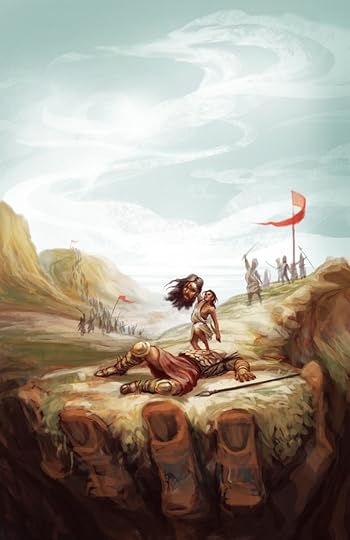
That is a very interesting way of looking at it, and explains why so many of these tropes can still feel fresh and exciting. I see a lot of that in your book In Search of Sacha. Which tropes/archetypes did you want to focus on in ISOS?
With In Search of Sacha I wanted to focus mostly on coming of age or maturing by way of love or heart break. I had dealt with a heart break around the time I started writing it and it baffled me how much such a thing can upturn my life. I couldn’t make heads or tails of what to do next with myself for a while there and so I wanted to write about it. I wanted to express the darkness one can easily sink into and with Sacha explore the darkness. But because I extended the creation process for ISOS over such a long time I found myself coming back to it over the years to expand on other themes. Later, as a married man and father, I was better able to portray parenthood and the sacred institution of marriage with better understanding. And though it is shown in something of an idealized state, the relationship between Elysia and Amar, Sacha’s parents, are what I like most about ISOS. Even though those interactions are brief, there is a nuance there that I hope people pick up on.

One thing I enjoyed about ISOS were the subtle religious elements. There was nothing explicitly stated, but it seemed like Elysia and Amar, and by extension Sacha, were almost like emissaries of heaven. Was this intentional, or am I reading too much into it?
It was intentional. I’ve always been a person to lean on my spiritual life to understand reality, but in the last couple of years of the long sporadic thirteen years process of writing ISOS something happened to me. I had accepted Jesus Christ back into my life as my Lord and Savior. I had left the path around the age of 18 after I came across hidden information and conspiracy theories. This was 1998, well before the internet was readily available, and so I turned to the New Age spiritual relativism you find so many people stumbling upon when they feel detached in the modern world. But even after so many spiritual sojourns, via rigorous meditation, into a vivid dream world I was lead to atheism twelve years later. As an atheist I convinced myself it was all delusions of my psyche but could never shake how real and solid some of those dreams felt. Even though this phase lasted seven years of my life I never felt I could communicate my spiritual explorations and the relief of prayer to my fellow atheist at the time. They always looked at me confused and didn’t understand how I could call my self an atheist. In 2016 God started to chip away at those notions and finally revealed himself anew to me in 2017, praise be! This is when I got a new shot of inspiration and knew I had to go back to ISOS and revitalize it with the Holy Spirit. And though it is subtle, I am glorifying God and Christ in every page.
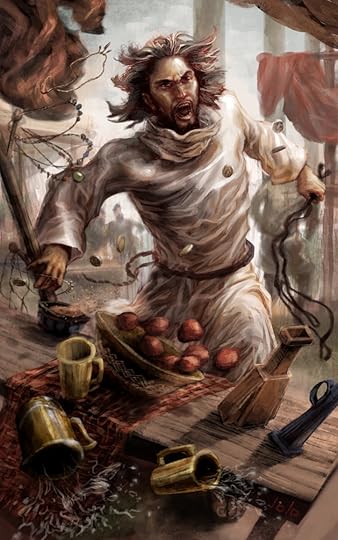
That is awesome. I love seeing these spiritual themes reflected maturely and thoughtfully in works of art. It’s important for believers to get these messages out in a way that is not off-putting but inspiring. Your personal transformation is very interesting as well. A few questions here about that:
1. What helped guide you back to Christianity; that is, were there any particular people/works that aided your return?
2. Where do you think we are as a culture and how can the arts help, if at all, in providing spiritual guidance?
Seeing what’s happening in culture, the division and the dysfunction, and the ramping up to violence and destruction in the streets should wake most any person up. When I thought about what could be the true cause and solution to this all it became very clear. The degeneracy embraced by the progressive left has one root cause and that is the complete abandonment of God. And within my atheistic world view I had to acknowledge that there was a contradiction of framing what I knew about the world and people. I realized that we can not escape serving a master. And even though a Libertarian/An-Cap would be hard pressed to admit it, he too serves a master, and it isn’t God, the Almighty. And I know they will argue voluntary vs involuntary here, or legitimate authority vs illegitimate authority, but truly I’ve found it makes no difference. Authority is authority and we get the rulers we deserve. Once I had found myself in that humble place and with my guard down, God did his work within me to reveal with simple logic his existence and love. An eternal father of truth, love and order/beauty can not be denied.
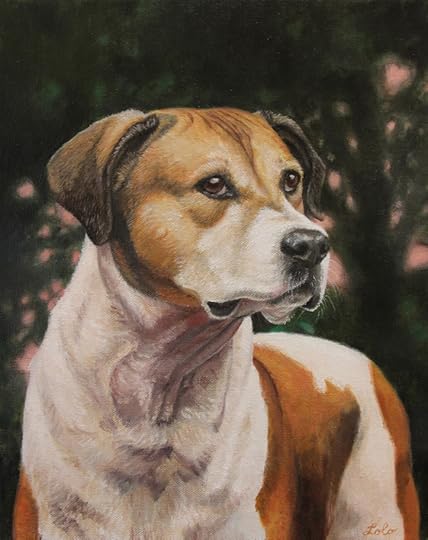
As for the personalities that inspired me, there are many. But probably most inspiring was watching Owen Benjamin’s and Roosh’s transformation on their stream.
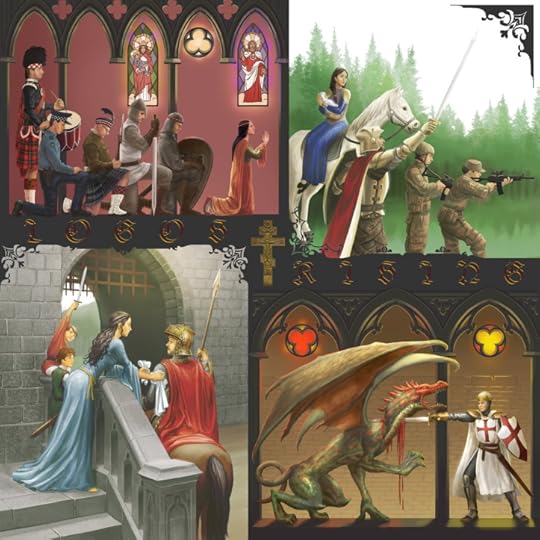
We are at the end of a line as a culture. There may still be more to fall, but the draw of the dark and edgy has worn itself out. Good humor, honor and beauty are the only saving grace we can hold on to now. The arts have always helped to inspire people live with more meaning, but when so much of it has been focused on meaningless relativism and sensual pleasures, it’s no wonder that society has gone down this fallen path. The arts should reflect and emphasize what we value most about society, and that isn’t to say that dark and horrific themes should not be explored, just that we keep our eyes set on what matters and what gets us out of the darkness. Those things are in this order: God, family, & community/nation.
If art isn’t serving the good, the beautiful, and the true, then what IS it serving? That’s a rhetorical question, by the way, because like you said, we all serve A master. The question is: which one?
I like to think we can create something new and good from the wreckage of the old.
That’s where people like you come in. What were some of your recent projects, and what do you have brewing in the future?
I recently worked with James Fox Higgins on his latest music album LOGOS RISING. When he first reached out to me I just knew he was working on something epic because the times are calling to be epic and I had prepared myself to try and match that level that I was anticipating from him. When I finally heard the demos I was blown away and so I set out not to just give him one or two pieces but a whole extensive series of seven paintings to go along with the phenomenal music and he agreed. I also recorded video of the painting process for each of the seven paintings and we have set them to some of the songs from the album for some make shift music videos. You can find one of these now playing to JFH’s “This is America” song. It’s great! If you haven’t heard it yet, you should and then do yourself a favor and go get the whole album and prepare for a musical feast in glory to God.
As for what I’m working on, even though I’ve been taking notes on what my next book will be, most of my attention these days has been on working on the house I moved my family into a few months ago. We’re making a lot of improvements there and things are looking good, but it hasn’t given me much breathing room to really get into the mode required of me to produce something like ISOS. During these times I’ve done some stand alone paintings for jobs here and there and some promotional pieces for ISOS you can see on my site, but as soon as I have something more substantial to share you’ll be the first to know.

Nice!
A few more questions if that’s okay, more about the nitty gritty of art, because I find it interesting :
Your use of colors is incredibly effective and very impressive, always nailing the mood of the piece (I know it does for the covers you’ve painted for me). Do you have some sort of method for determining a color palette, or is it more of a feel thing?
Thank you, I’m glad you think so! I’d have to say it’s more of a feel thing. You know, there are some colors that just work so well when placed next to each other. Like the purple and green used in the sky of The Last Ancestor cover art, Or even the yellow of the title text against that sky. But really what’s most important beyond color are the values of light and dark used. If that range and atmosphere is right you can slap almost any color on there and it will work. Sometimes I’ll make a painting completely in black and white, or monochromatic, and later simply and effortlessly wash some color over it. Even though the step of applying the color only takes a fraction of the time it takes to develop the values of the image, you would think the painting must have been designed from the ground up with color in mind, but you would be wrong. This is the importance of lighting and values.

That’s pretty remarkable to see, which is one reason I enjoy your process videos so much.
On a related point, when somebody gives you a verbal description of what they’d like a piece to look like, what is your process for translating that into a work of art? I ask because you’re somehow able to take my semi-coherent requests and create exactly what I was thinking about in my head.
Yes, people should check out the video of my painting process for the cover art of Alexander’s The Second Sojourn playing at like 400x times the speed. Watching about 30 hours of work compressed into about 5 minutes playing to “The Spirit of Radio” by RUSH is a lot of fun.
What I do when someone gives me a description of something they’d like to see is make a few rough sketches of that thing from different perspectives. Sometimes, one of the sketches will be something the client didn’t necessarily ask for, but is close enough, and I throw it in for variety. After I’ve presented the sketches and we’ve decided on which angle to work from then I usually ask what time of day or type of lighting or mood we are looking for. With that information, I have at it and try my hand at it. With you, I think I’ve been lucky at getting it right or close to right right off the bat. Sometimes, there are clients that don’t seem to know what they like and ask me to make so many changes that it can become frustrating and I have to remind them how far we are straying from what they originally asked for. I really don’t like reaching the point where I have to tell someone that any more changes will cost them extra.

It is impressive to see in action. I can absolutely understand how rough it must be when a client decides they want something totally different than what you started working on. But that’s the life of an artist I suppose.
One last question: if you had an overall or overarching theme or aesthetic for your art, how would you describe it?
This is hard for me to say because there are many times that I look at my art and I feel like it isn’t where I want it to be. Sometimes it feels so far away. What concerns me about the theme or aesthetic I’d like to achieve some day with my work is beyond whether it is realistic or cartoony or something in between, but that it is something that’ll uplift the spirit. If it is stylized in one way or another isn’t so important to me, but if I can paint things that inspire awe and joy I’d be happy. With my art I’d like to incite a sense of mystery, but also a sense of revelation. I’m not there yet, but I am working to achieve it and that way I may honor my Lord properly.

Awesome. Thanks so much man! Where is the best place for people to find you online to see your art, buy your books, and commission pieces?
No problem, anytime! You can find a link to all my social media accounts and my YouTube page on my website, LolosArt.com. And you can find my book, In Search of Sacha, on there too. I hope folks check it out, it has a very cool trailer!
Interesting People, Vol. 3: Manuel Guzman

Manuel Guzman might be familiar to you if you’ve read my books–he is the cover artist for The Last Ancestor and The Second Sojourn, as well as the artist and author of the storybook In Search of Sacha. In addition to being a creative and talented artist, he’s an interesting guy I think you’ll enjoy hearing from.
Manuel was nice enough to answer a bunch of my questions over the Internet—my questions are in bold and his answers are in regular text. Enjoy, and when you’re done, check out his work and snag a copy of In Search of Sacha.
Who are you and what is it that you do?
I’m Manuel Guzman or Lolo as most my friends and family call me and I’m an illustrator from NYC. Well, now I guess I can include author to that description.
When did you start drawing/painting and what got you really into art in the first place?
I became fascinated with visual art because my father drew and painted as a hobby and I was blown away by what he was able to do. At around the age of 7 or 8 I made some friends that also liked to draw and that is when I decided to take it more seriously and competed with them on who could make the more impressive drawing. It was around then that I knew this would be a part of me forever.
I have to say you have a very unique style, even with your digital art and the more sci-fi oriented work it has this very ethereal almost watercolor-like quality to it. What were/are some of your biggest artistic influences?
Early on I was very inspired by American comic book art, specifically Marvel. I loved to draw Spiderman, The Hulk and Ironman, among others. But in my teen years in the mid 1990s I became more exposed to Japanese Anime art and that grabbed such a hold of me that I began trying to emulate that in my work more and more, until my last years as a teenager. That is when I became more aware of great American illustrators like Frank Frazzetta, J. C. Leyendecker and N.C. Wyeth. These were the legendary artist that helped me mature into a painter, and continue to do so. Of course, then there are all the great renaissance masters and the great impressionist artists that have affected me deeply as well, but thematically I will always resonate with what these American Legends were doing. As for the watercolor look to my digital work, well while I very much enjoy the aesthetic of water colors I can’t say that it is necessarily intentional. I don’t really know why so much of my digital work has such a quality, it doesn’t happen when I work with oils. Then it just looks like oils. And while I really like to do water color art, I haven’t made much of it in the last few years.

Okay. Very interesting. That could just be my lack of knowledge of materials/techniques speaking.
It’s interesting you mentioned the American masters like Frazetta, Wyeth, etc., because it’s a lot of these qualities that caught my attention and made me think you’d be perfect to do the covers of my books. Have you always been a fantasy/sci-fi fan yourself (comics aside), or is it more that you appreciate that aesthetic and vibe? And if you are a fan, what are some of the fantasy/sci-fi books, movies, etc. that you’re into?
Not at all, I’ve heard it many times that my digital work looks like water colors.
While I have been a big fan of these genre’s I wasn’t ever a big reader. I mostly kept to the animation and film variations of this expression. And yes, I resonate a lot with this aesthetic because I believe that somehow the stories told through the fantasy/scifi genre can speak more closely to the truth of life. I think that the fantastical elements or futuristic/technological aspects of these genres add the proper emphasis to issues that we deal with as people. By adding that bit of escapism that these genres provide we detach enough from reality to then be able to analyze the themes covered in these stories. The archetypes of legendary heroes and monsters never grow old and help us understand what we are dealing with in life.

That is a very interesting way of looking at it, and explains why so many of these tropes can still feel fresh and exciting. I see a lot of that in your book In Search of Sacha. Which tropes/archetypes did you want to focus on in ISOS?
With In Search of Sacha I wanted to focus mostly on coming of age or maturing by way of love or heart break. I had dealt with a heart break around the time I started writing it and it baffled me how much such a thing can upturn my life. I couldn’t make heads or tails of what to do next with myself for a while there and so I wanted to write about it. I wanted to express the darkness one can easily sink into and with Sacha explore the darkness. But because I extended the creation process for ISOS over such a long time I found myself coming back to it over the years to expand on other themes. Later, as a married man and father, I was better able to portray parenthood and the sacred institution of marriage with better understanding. And though it is shown in something of an idealized state, the relationship between Elysia and Amar, Sacha’s parents, are what I like most about ISOS. Even though those interactions are brief, there is a nuance there that I hope people pick up on.

One thing I enjoyed about ISOS were the subtle religious elements. There was nothing explicitly stated, but it seemed like Elysia and Amar, and by extension Sacha, were almost like emissaries of heaven. Was this intentional, or am I reading too much into it?
It was intentional. I’ve always been a person to lean on my spiritual life to understand reality, but in the last couple of years of the long sporadic thirteen years process of writing ISOS something happened to me. I had accepted Jesus Christ back into my life as my Lord and Savior. I had left the path around the age of 18 after I came across hidden information and conspiracy theories. This was 1998, well before the internet was readily available, and so I turned to the New Age spiritual relativism you find so many people stumbling upon when they feel detached in the modern world. But even after so many spiritual sojourns, via rigorous meditation, into a vivid dream world I was lead to atheism twelve years later. As an atheist I convinced myself it was all delusions of my psyche but could never shake how real and solid some of those dreams felt. Even though this phase lasted seven years of my life I never felt I could communicate my spiritual explorations and the relief of prayer to my fellow atheist at the time. They always looked at me confused and didn’t understand how I could call my self an atheist. In 2016 God started to chip away at those notions and finally revealed himself anew to me in 2017, praise be! This is when I got a new shot of inspiration and knew I had to go back to ISOS and revitalize it with the Holy Spirit. And though it is subtle, I am glorifying God and Christ in every page.

That is awesome. I love seeing these spiritual themes reflected maturely and thoughtfully in works of art. It’s important for believers to get these messages out in a way that is not off-putting but inspiring. Your personal transformation is very interesting as well. A few questions here about that:
1. What helped guide you back to Christianity; that is, were there any particular people/works that aided your return?
2. Where do you think we are as a culture and how can the arts help, if at all, in providing spiritual guidance?
Seeing what’s happening in culture, the division and the dysfunction, and the ramping up to violence and destruction in the streets should wake most any person up. When I thought about what could be the true cause and solution to this all it became very clear. The degeneracy embraced by the progressive left has one root cause and that is the complete abandonment of God. And within my atheistic world view I had to acknowledge that there was a contradiction of framing what I knew about the world and people. I realized that we can not escape serving a master. And even though a Libertarian/An-Cap would be hard pressed to admit it, he too serves a master, and it isn’t God, the Almighty. And I know they will argue voluntary vs involuntary here, or legitimate authority vs illegitimate authority, but truly I’ve found it makes no difference. Authority is authority and we get the rulers we deserve. Once I had found myself in that humble place and with my guard down, God did his work within me to reveal with simple logic his existence and love. An eternal father of truth, love and order/beauty can not be denied.

As for the personalities that inspired me, there are many. But probably most inspiring was watching Owen Benjamin’s and Roosh’s transformation on their stream.

We are at the end of a line as a culture. There may still be more to fall, but the draw of the dark and edgy has worn itself out. Good humor, honor and beauty are the only saving grace we can hold on to now. The arts have always helped to inspire people live with more meaning, but when so much of it has been focused on meaningless relativism and sensual pleasures, it’s no wonder that society has gone down this fallen path. The arts should reflect and emphasize what we value most about society, and that isn’t to say that dark and horrific themes should not be explored, just that we keep our eyes set on what matters and what gets us out of the darkness. Those things are in this order: God, family, & community/nation.
If art isn’t serving the good, the beautiful, and the true, then what IS it serving? That’s a rhetorical question, by the way, because like you said, we all serve A master. The question is: which one?
I like to think we can create something new and good from the wreckage of the old.
That’s where people like you come in. What were some of your recent projects, and what do you have brewing in the future?
I recently worked with James Fox Higgins on his latest music album LOGOS RISING. When he first reached out to me I just knew he was working on something epic because the times are calling to be epic and I had prepared myself to try and match that level that I was anticipating from him. When I finally heard the demos I was blown away and so I set out not to just give him one or two pieces but a whole extensive series of seven paintings to go along with the phenomenal music and he agreed. I also recorded video of the painting process for each of the seven paintings and we have set them to some of the songs from the album for some make shift music videos. You can find one of these now playing to JFH’s “This is America” song. It’s great! If you haven’t heard it yet, you should and then do yourself a favor and go get the whole album and prepare for a musical feast in glory to God.
As for what I’m working on, even though I’ve been taking notes on what my next book will be, most of my attention these days has been on working on the house I moved my family into a few months ago. We’re making a lot of improvements there and things are looking good, but it hasn’t given me much breathing room to really get into the mode required of me to produce something like ISOS. During these times I’ve done some stand alone paintings for jobs here and there and some promotional pieces for ISOS you can see on my site, but as soon as I have something more substantial to share you’ll be the first to know.

Nice!
A few more questions if that’s okay, more about the nitty gritty of art, because I find it interesting :
Your use of colors is incredibly effective and very impressive, always nailing the mood of the piece (I know it does for the covers you’ve painted for me). Do you have some sort of method for determining a color palette, or is it more of a feel thing?
Thank you, I’m glad you think so! I’d have to say it’s more of a feel thing. You know, there are some colors that just work so well when placed next to each other. Like the purple and green used in the sky of The Last Ancestor cover art, Or even the yellow of the title text against that sky. But really what’s most important beyond color are the values of light and dark used. If that range and atmosphere is right you can slap almost any color on there and it will work. Sometimes I’ll make a painting completely in black and white, or monochromatic, and later simply and effortlessly wash some color over it. Even though the step of applying the color only takes a fraction of the time it takes to develop the values of the image, you would think the painting must have been designed from the ground up with color in mind, but you would be wrong. This is the importance of lighting and values.

That’s pretty remarkable to see, which is one reason I enjoy your process videos so much.
On a related point, when somebody gives you a verbal description of what they’d like a piece to look like, what is your process for translating that into a work of art? I ask because you’re somehow able to take my semi-coherent requests and create exactly what I was thinking about in my head.
Yes, people should check out the video of my painting process for the cover art of Alexander’s The Second Sojourn playing at like 400x times the speed. Watching about 30 hours of work compressed into about 5 minutes playing to “The Spirit of Radio” by RUSH is a lot of fun.
What I do when someone gives me a description of something they’d like to see is make a few rough sketches of that thing from different perspectives. Sometimes, one of the sketches will be something the client didn’t necessarily ask for, but is close enough, and I throw it in for variety. After I’ve presented the sketches and we’ve decided on which angle to work from then I usually ask what time of day or type of lighting or mood we are looking for. With that information, I have at it and try my hand at it. With you, I think I’ve been lucky at getting it right or close to right right off the bat. Sometimes, there are clients that don’t seem to know what they like and ask me to make so many changes that it can become frustrating and I have to remind them how far we are straying from what they originally asked for. I really don’t like reaching the point where I have to tell someone that any more changes will cost them extra.

It is impressive to see in action. I can absolutely understand how rough it must be when a client decides they want something totally different than what you started working on. But that’s the life of an artist I suppose.
One last question: if you had an overall or overarching theme or aesthetic for your art, how would you describe it?
This is hard for me to say because there are many times that I look at my art and I feel like it isn’t where I want it to be. Sometimes it feels so far away. What concerns me about the theme or aesthetic I’d like to achieve some day with my work is beyond whether it is realistic or cartoony or something in between, but that it is something that’ll uplift the spirit. If it is stylized in one way or another isn’t so important to me, but if I can paint things that inspire awe and joy I’d be happy. With my art I’d like to incite a sense of mystery, but also a sense of revelation. I’m not there yet, but I am working to achieve it and that way I may honor my Lord properly.

Awesome. Thanks so much man! Where is the best place for people to find you online to see your art, buy your books, and commission pieces?
No problem, anytime! You can find a link to all my social media accounts and my YouTube page on my website, LolosArt.com. And you can find my book, In Search of Sacha, on there too. I hope folks check it out, it has a very cool trailer!
January 8, 2021
Book Review: Neon Harvest by Jon Mollison
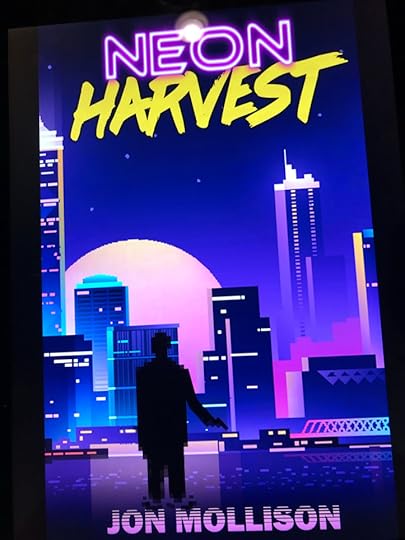
I’ve never read a book by Jon Mollison I haven’t enjoyed. Whether it’s fun sci-fi or intense sword-and-sandals action, Mollison delivers the goods.
The sci-fi noir of Neon Harvest is no exception. Set on an unnamed off world colony planet in an unnamed city that feels like 1980s crime-riddled Miami, Neon Harvest has the day-glo vibe of The Miami Connection (minus ninjas) with the noir sensibilities of The Big Sleep. It’s a compelling and wholly unique aesthetic that totally works.
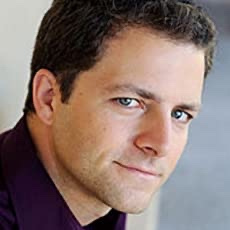 Jon Mollison
Jon MollisonDigger is a former athlete turned private eye fresh off a crushing failure of a case. All he wants is to get off this planet and go to another colony world, one cleaner both environment- and people-wise. Despondent, he’s hired by his old friend/guy who ended his sports career True Drexert with one last case with a payoff so big Digger will be one the next ship off of the planet: rescue Virginia Mance, daughter of tech oligarch Niko Mance, aka The Necromancer, who has gone missing and was last seen in the company of a notorious sex trafficker.
So into the city’s seamy underbelly Digger goes once again, hoping that this score is enough to settle his debts and start a new life.
Neon Harvest is a gritty, take-no-prisoners detective/chase tale with a gloss of corporate espionage told at a fast pace with brutal action that never overstays it’s welcome and classic dialogue that crackles with life. Further, underneath it all, Neon Harvest has a surprisingly wholesome moral core. Digger is a paladin, doing right because it’s the right thing to do in a world that grinds people like him into dust. It’d be easy for Digger to sell out like so many others, take the golden ticket, and life the easy life, but the price of doing so is too much even for a down-on-his-luck sad sack like Digger.
In other words, you can’t help but root for the guy.
Neon Harvest is another pulp-inspired tale from Mollison, who is rapidly becoming a master at whatever genre he touches. Highly recommended. Buy Neon Harvest here.
January 7, 2021
The Professor is Still Missed
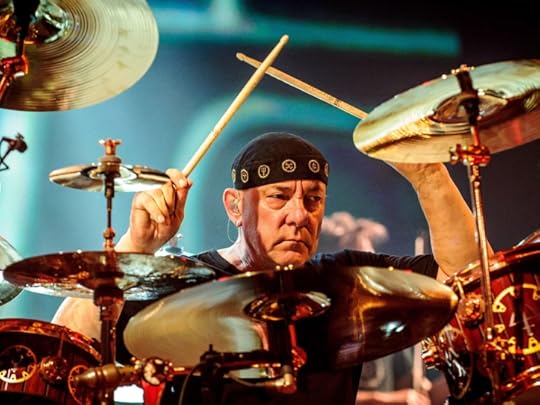
One year ago today, Rush drummer and lyricist Neil Ellwood Peart succumbed to the form of brain cancer known as glioblastoma at the age of 67. More than any other celebrity death, Peart’s passing affected me to such a degree that I wrote an entire book about Rush fandom and why his life, his work, and his death resonated with so many people who never knew him.
At the end of the day, my conclusion was that Peart’s lyrics and Rush’s music made people feel good. His words never condescended to listeners, never cast blame at this group or that, and expressed a childlike fascination with the world, with nature, and with history, to deliver deep, universal truths about the human condition. Far from the typical rock fare about sex and drugs, with Peart penning the lyrics to accompany Geddy Lee and Alex Lifeson’s wonderfully wild prog-rock compositions, Rush became such a beautifully strange and thought-provoking hard rock band.
Anyone who tells you that rock music is, by its very nature, degenerate, has obviously never listened to Rush.
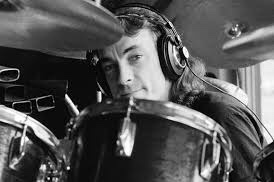
It is rare that any celebrity, regardless of their field, is as universally loved and respected as Neil Peart was. In addition to his words which gave so much meaning and comfort to fans, to his drumming which propelled Rush’s music to new and exciting heights, the way he lived his life and his work ethic were also an inspiration. People I interviewed for my book and fans who shared their stories all had the same thing to say: It was like we all knew him. Nobody had a negative thing to say about Neil, and indeed he is one of the few pop culture figures who had an unabashedly positive impact on the culture at large.
We are all better for having had Neil Peart in the world, and we are poorer for his having exited it.
Brian Hiatt of Rolling Stone, who penned many fantastic Rush articles over the years, many of which I used for my book, has a great commemorative piece out today where he speaks to both Lee and Lifeson, as well as Peart’s second wife Carrie Nuttall, who are talking explicitly about Neil Peart’s last days for the first time since he died. It’s worth a read, and it will just make you appreciate Peart’s character and personality even more.

I’ll close this piece by sharing a few of my favorite Peart lyrics. I’m also going to be doing in-depth reviews of all Rush albums over the course of this year, but for now here are ten of my favorite Neil Peart lyrics in no particular order:
1. “Mission”: A rumination on how we admire artists and their work, but on the flip side how artists would likely gladly exchange the turmoil in their lives that helped them produce art for “something a little more plain . . . maybe something a little more sane.”
2. “Bravado”: Just a gorgeous song about how we so often pursue our dreams at a great personal cost.
3. “Marathon”: Life is a race, get it? But this hackneyed metaphor becomes utterly inspiring in Peart’s capable hands.
4. “Red Barchetta”: The most thrilling song about driving ever created. Peart imagines a world after something called the Motor Law bans the internal combustion engine. Our unnamed narrator has an uncle who kept a Red Barchetta in his shed that he lets his nephew drive regularly to “commit [his] weekly crime.”
5. “Natural Science”: It’s about tide pools as a metaphor for how we far too often fail to see outside of our little universes! But it’s also a rumination on the need to make sure science, like nature, is tamed to our needs and not vice versa. But it’s also about how the music industry dehumanizes art and artists. And it’s also about the need for honesty to prevail. And it just rocks.
6. “Time Stand Still”: A beautiful song about growing older and wanting to be present in the NOW, not focus on the past or continually worry about the future. “Available Light” from the following album is in much the same vein, but “Time Stand Still” did it first.
7. “The Pass”: A hauntingly powerful anti-suidice song. The number of people who told me that this song literally saved their lives is staggering and testament to why Peart meant so much to so many people.
8. “Subdivisions”: This, along with “The Analog Kid” from the same album, absolutely nail what being a small-town teenager is like. I still get chills listening to it.
9. “Wish Them Well”: Some people are toxic and not worth keeping in your life. You don’t have to hate them or be mean to them. Just “turn your back and walk away.”
10. “The Garden”: The final song on Rush’s final studio album is one of their finest. Peart pens the ruminations of an old man (the main character in the Clockwork Angels concept album) about what truly matters in life. It’s utterly tear-inducing.
There are so many more, but these are just some of my favorites.
Rush will be missed, as will Neil, because without Neil, there is no Rush. All of us fans selfishly held out hope that, despite retiring after their triumphant 2015 40th anniversary tour, there might be more albums and a one-off show or two. That can never happen now, but we have 18 studio albums (Neil didn’t play on their debut), ten live albums, and hundreds of lyrics to remember him by.
Godspeed, Professor.
Dreamers & Misfits, my smash-hit book about Rush fans, is available here.

January 5, 2021
Interview with Periapsis Press

Just wanted to pass a link to an interview about The Second Sojourn I did with Katie Roome of Periapsis Press. Great questions, and a great site. Periapsis Press is doing exactly what the independent publishing world needs: promotion and honest reviews of new works. Check out the interview here, check out The Second Sojourn here, as well as The Last Ancestor, and browse around on the Periapsis website for some exciting new reads!
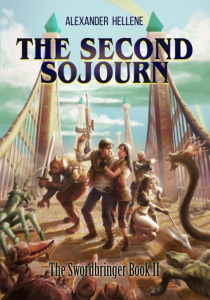
January 4, 2021
Book Review: The Gulag Archipelago by Aleksandr I. Solzhenitsyn: Part Two: “Perpetual Motion,” Chapter Two, “The Ports of the Archipelago”

Just as all transit prisons are pointless, talk about transit prisons is pointless, and, in all probability, this chapter, too, will turn out to be the same . . .
After discussing the so-called ships of the Archipelago (the Stolypin and Black Maria train cars that ferried prisoners to and fro throughout Russia), Solzhenitsyn then turns to the Archipelago’s ports, the transit prisons where captives were held before being transported to the Gulag proper.
And the movement of people was endless. Prisoners were brought in and taken away, singly and in groups, and driven off in prisoner transports. Appearing so businesslike on the surface, so planned, this movement was marked by such stupidity that one can hardly believe it.
This fits in with the title of Part Two of The Gulag Archipelago: “Perpetual Motion.” Prisoners were always being shuffled throughout the Soviet Union, and they had to be stored somewhere.
Spread out on a large table the enormous map of our Motherland. Indicate with fat black dots all provincial capitals, all railroad junctions, all transfer points where the railroad line ends in a river route, and where rivers bend and trails begin. What is this? Has the entire map been speckled by infectious flies? What it is, in fact, is precisely the majestic map of the ports of the Archipelago. These are not, to be sure, the enchanted ports to which Aleksandr Grin enticed us, where rum is drunk in taverns and men pay court to beautiful women.
It is a rare zek [prisoner] who has not known from three to five transit prisons and camps; many remember a dozen or so, and the sons of Gulag can count up to fifty of them without the slightest difficulty . . .

In practicality, these transit prisons are very similar to the Archipelago’s ships, right down to the thieves who, favored by the guards, took what they wanted from prisoners and enforced that rough form of prison justice that strikes so much terror into the hearts of those subjected to it. And these thieves make sure that anything sent to prisoners by their families and loved ones are extracted as a tax, because having possessions in a transit prison makes you a target:
Foolish relatives! They ash about in freedom, borrow money (because they never have that kind of money at home), and send you foodstuffs and things–the widow’s last mite, but also a poisoned gift, because it transforms you from a free though hungry person into one who is anxious and cowardly, and it deprives you of that newly dawning enlightenment , that toughening resolve, which are all you need for your descent into the abyss. Oh, wise Gospel saying about the camel and the eye of the needle! These material things will keep you from entering the heavenly kingdom of the liberated spirit.
Solzhenitsyn himself tells the story of how he confronted these thieves upon being interred in the Krasnaya Presnya prison, how after having his food stolen he demanded that he be allowed onto one of the bottom bunks. The thieves complied, of course, forcing the people who had been on the bottom bunk to then lie under the bunk. And Solzhenitsyn realized he had made himself just another version of those thieves, just lower on the totem pole, taking advantage of those even lower.
The transit prisons served to harden the interred and prepare them for camp life, gradually inducting them into the hardships to come. Those in the Gulag found themselves bragging about the prisons they stayed in and bandying about tales of their hardships like badges of honor. Anything to stave off depression and insanity. Solzhenitsyn claims that the prison he was in, Moscow’s Krasnaya Presnya, was somewhere “we could somehow stretch out our legs at night, and the bedbugs were moderate, and the flies bit us all night long as we naked and sweaty under the bright lights . . .” Other transit prisons were even worse: “The deeper into the Archipelago one got, the more obviously did the concrete docks of the Archipelago become transformed into wharves made of wooden pilings.” Not transit prisons are created equal.
 The former Karabas transit prison.
The former Karabas transit prison.Neither is prison work. This chapter ends with a dire warning that “general-assignment work” is to be avoided at any cost.
There are other strange tales, such as that of the supposed Swedish noble stuck into a transit prison. This youth hadn’t even had his flaxen locks chopped off yet! No, this Westerner was a communist sympathizer who was allowed into the USSR and feted by party officials until he lost his nerve when the time came to renounce his homeland. This pseudonymous youth then became somewhat of an ultra-nationalist and refused any and all entreaties to disown the West and pledge allegiance to the East. Of course they could not let him go: his will was too great and there cannot be any tales of those who withstood the Soviet system to inspire any other prisoners, now could there?
But if you were in one of these transit prisons, you were already lost. There was only one sensible path for a prisoner to take:
Submissiveness to fate, the total abdication of your will in the shaping of your life, the recognition that it was impossible to guess the best and the worst ahead of time but that it was easy to take a step you would reproach yourself for–all this freed the prisoner from any bondage, made him calmer, and even ennobled him.
Takeaways:
People storage! The powers that be are always looking for places to warehouse people in, whether they be undesirable citizens or prisoners, the state has to stick them somewhere. And those places don’t always have to be nice.
If you don’t play ball with the state after being extended an offer, your life is likely over.
Having more than others makes you a target. This is a lesson for life in general and not just for those in prison.
It is all too easy to keep kicking the bad fortune down hill and callous over your own heart in order to eke out some comforts while ignoring those who have to face the consequences of your actions.
January 3, 2021
2021 Goals

Let’s talk about the new year going forward. Here are a few things I’d like to have accomplished by this time in 2022:
Have The Swordbringer trilogy completed.
Have another of my standalone books published (still debating which one).
Have a short story published in an anthology.
Write more articles that hopefully get accepted by The American Spectator.
Nothing too lofty here. There are other personal and professional goals I have for the new year, but who needs to hear those?
And in other news, The Second Sojourn is now available in paperback. Buy it here.
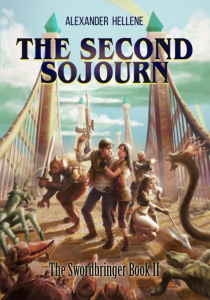
January 1, 2021
Meet the New Year

Same as the old year.
Seriously, though: I sincerely wish you all a happy new year and hope that it is filled with good fortune and God’s blessings.
But I’m not really joking in saying 2021 is going to be more of the same. I firmly sense that since 2000, America has been treading water in nearly every metric, and in fact has been getting slightly worse year over year. 2020 seemed like a tipping point and I think this decline which began in earnest on 9/11 but for which the seeds were planted decades ago, will accelerate. There will be more lockdowns over what is essentially a flu, more political and racial violence, more consolidating of our institutions by the forces of terminal wokeness.
Speaking of which, the self-styled masters of the universe will continue implementing the American privatized version of China’s social credit system. And because it’s driven by woke capital, they will face no repercussions because the Bill of Rights mainly protects citizens from (some) government action, so “Private business, bro” the libertarian and conservative flag-wavers will continue to bleat.
It won’t matter who is President come January 21, because we have one party that doesn’t really care about any of us. It cares about its own power. C’est la vie.
Culture will continue to be frozen in time yet simultaneously decline: we’re not innovating, and what we have just gets worse. Pale imitations of pale imitations. Everything is backwards looking, and what visions do gaze ahead contemplate a future so horrifying that returning to the life of a nomadic herding tribe seems more appealing. Props to Elon Musk who at least tries to be optimistically future-oriented.
But all is not lost. These are all macro trends. On the micro level, you have control over how you react. Get healthy, physically, mentally, and spiritually. Build strong families. Play the game just enough to accumulate some wealth. Strengthen your community and family ties. Don’t live in constant fear.
2020 served to open many people’s eyes to how rotten our system and those who run it are, and how rotten it has all been for a long time. The conspiracy kooks of the 1980s–and earlier–have been mostly vindicated. Normal people are getting wise to the con job that had been pulled on them most of their lives. Our job isn’t to say “I told you so!” but to say “Welcome. Here’s what we do.”
Don’t give in to despair. Don’t give in to violence. Don’t give in to blind hatred. You can have fun and be awesome while ignoring the noise and those bozos in Washington and in your statehouse and in city hall. The Emperor is not only naked, but is stupid and ugly. Laugh and ignore and live your life.
Now that this is out of the way, some stats:
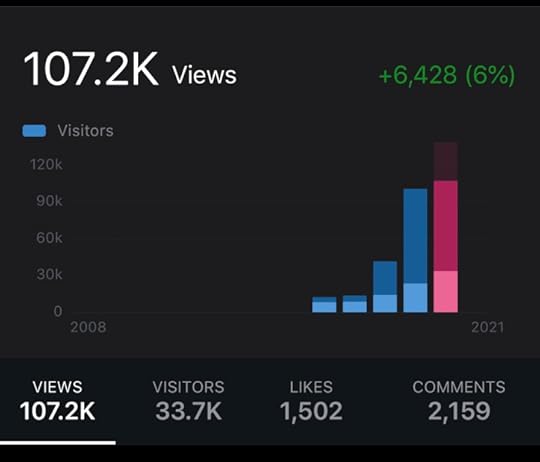
Blog views and unique visitors continued to climb in 2020. Oddly, I had slightly fewer likes and less than half as many comments as last year. More visitors and less interaction.
Strange. Perhaps my content was more engaging in 2019. I’ll have to go through last year’s posts and see which ones got the most engagement.
At least I was somewhat prolific, writing and publishing two books. They were both supposed to be out by summer. And then by September . . . and then before Thanksgiving . . .
I ended up getting Dreamers & Misfits out in November, and The Second Sojourn a few days before the year’s end.
Note to self: writing two books at the same time was not a good idea. I’m a bit farther behind on others I’d hoped to have finished outlining now, like Swordbringer Book 3, but I’ll get there. Contrary to many, 2020 was mostly pretty good, including personal and family stuff I’m not going to get into here.
Keep your chins up everyone: we’ll be all right. Keep fighting the good fight and running the race and remember to have fun. The powers that be hate it when you have fun.
December 30, 2020
The Second Sojourn Cover Art Process
How cool is this? The Swordbringer cover artist Manuel Guzman, aka Lolo has created a video of his creation process for The Second Sojourn‘s cover check it out–then check out the book!
Great tunes in the video too.
December 29, 2020
The Second Sojourn Out Now!
I’m excited to announce that The Second Sojourn, Book II of The Swordbringer is available now for download!
Terror strikes the heart of Pysh!
The Global Union has tracked the Canaanites across the galaxy, hellbent on finishing the job of extermination. But first they need to recover a secret, one that will explain everything.
A distress signal from the East brings Garrett, Ghryxa, and their friends closer to the answers about what happened on Earth. The lost ship survives! But to find it they must cross the Waran Steppes, and an endless swamp filled with ancient, deadly creatures.
Pursued by assassins, Garrett must make the hard choices and be a hero like his late father. Escaping the High Lord was just the beginning.
More sword-and-planet adventure! More freaky alien creatures! Another spectacular cover by Manuel Guzman! Buy it here!





